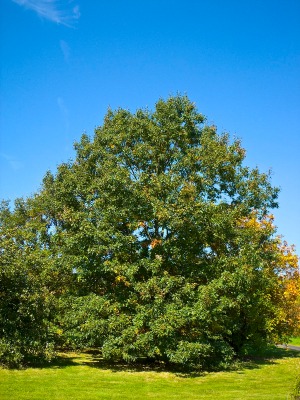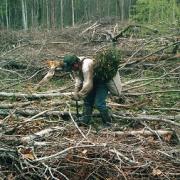Trails provide easier access to places you want to go in your woods and more opportunities to use your woods for recreation. If you have decided to create trails in your forest, the first steps you should take involve determining how you will want to use those trails and mapping relevant features in your woods. After completing those steps, you can decide where to position trails and then take action to clear the trails. Whether your trail design will highlight …
Water Balance
Adapted from: Mary Nichols. 2007. Chapter 3: Hydrologic Processes in Riparian Areas. In: G. Zaimes (ed). Understanding Arizona’s Riparian Areas. University of Arizona Cooperative Extension. AZ 1432. Available at http://cals.arizona.edu/pubs/natresources/az1432.pdf
Water balance is a method of book keeping used to summarize the amount of water cycling from the atmosphere, across land surfaces, into the ground, through plants, into the ocean, and back the atmosphere. It provides a good framework for understanding hydrologic processes. Water balances can vary year to …
Will Black Oaks Survive Climate Change in the Midwest?

The survival of some species of oaks, among them black oak, have been threatened as forested areas in North America are cleared for agriculture, urban development, and other forms of development. It is a major goal of many forest managers to maintain current populations of oak (Quercus spp.) for timber, wildlife, and conservation biology. Currently, black oak is distributed throughout …
Drought Risk and Tree Planting

The PINEMAP team produced a helpful publication on whether To Plant or Not to Plant, which includes a checklist of eight items for consideration before planting tree seedlings. The Fact Sheet, produced by the Texas Forest Service and Texas Agrilife Extension Service, refers to Texas, but the process for timber stand drought risk assessment is broadly applicable and not time-limited. Important considerations before planting include working with a qualified professional, assessing the site quality and soil moisture, …
Protect Your Forest Asset
Adapted from peer reviewed publication SREF-FM-0018 May, 2013. L. Jennings, L. Boby, W. Hubbard and M. Megalos. Protecting Your Forest Asset. www.sref.info.
Record droughts, rising temperatures, increased frequency and intensity of wildfires, insect and plan invasions, and more intense storm events all pose threats to the health of Southern forests. Scientists project that increases in temperature and changes in rainfall patterns will cause these disturbances to become more common, occurring with greater intensity or duration.
The use of …
Oregon Forests and Climate Change
Oregon State University Forestry & Natural Resources Extension started a blog in 2015 on Oregon Forests and Climate Change. The goal of the blog is to assist Oregon’s private forest owners in understanding basic climate science principles, anticipated impacts on managed forests, and options for adaptation and management. Several articles have posted to this blog already, and we provide specific links to them here. As OSU Forestry and Natural Resources Extension updates the blog, we will add the new …
Urban Forestry Video Series New Release!

Trees provide more than just beauty or a source of wood products. Rather, trees provide an assortment of economic, environmental, psychological and social benefits to humans. Energy savings are one such highly valued benefit or service urban trees provide. Did you know that just 17% shade on a building from trees for example can reduce power bills by $10/ month or that urban trees can lower surrounding temperatures by as much as 20° F? Alternatively, trees can reduce winter heating …
Webinars on Demand!
If you missed a climate and natural resources webinar of interest, check out the links below.
ANREP Climate Science Initiative Webinars:
“Extension Leadership with Community Climate Planning Scenarios”
“Benefiting Clientele and Educators through Climate Education Networking”
“Extension Climate Communication in Practice”
“Urban, Rural, and Remote: Extension Climate Adaptation Programs and Practices”
“FloriDays Cutting-Edge Extension”
“The North Coast Alignment Project” and “Delaware’s Climate Change Impact Assessment”
The Role of Universities in Climate Change Education and Research
ClimateWebinars.net:
Preventing Forest Tree Illness

Do not wait to act on insect and disease issues until after you see dead branches. Look for visible symptoms or signs of tree illness and learn how to prevent a favorable environment for organisms that harm trees. It is important to understand that successful methods for minimizing forest insect and disease problems are usually preventative, occurring before problems are noticed. Monitoring your forest for …

